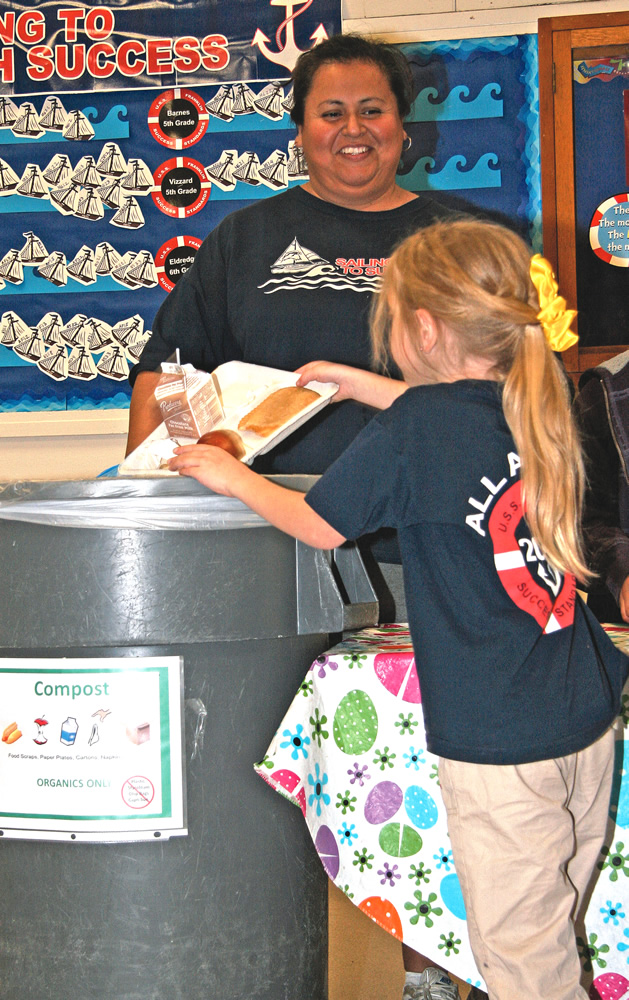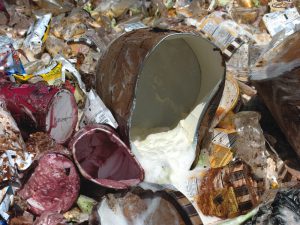City of Bakersfield implements collection and composting system at its 53 schools to handle all types of food packaging in order to get at the “leftovers.”
Kevin Barnes
BioCycle July 2012, Vol. 53, No. 7, p. 18
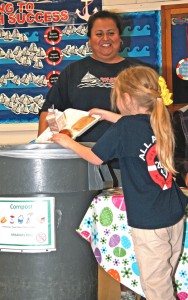
Existing 32- or 45-gallon barrels were relabeled for “organics” in the cafeterias. Most schools switched to trays made from paper instead of polystyrene foam.
Over seven years ago, the City of Bakersfield began performing pilot tests at its green waste facility to prepare for a full-scale organics composting program. The regional green waste facility, located on 97 acres, is one of the largest composting facilities in California. It is supported by a shared cost agreement with the County of Kern. Facility permit modifications were made to add food waste to the existing green waste system.
Motivation to expand food waste recycling was spurred by CalRecycle’s Strategic Directive 6.1 to divert 50 percent of the organics currently being disposed in landfills. Given 35 million tons of annual landfill disposal statewide, and a California waste characterization study that found 32 percent of the disposed material is organic, the 50 percent organic diversion goal will require 5.6 million tons/year of new composting. On a per-capita basis for 37 million California residents, that is “only” 13 ounces/day/Californian. But based on this average, Bakersfield (population 330,000) will need to divert 49,000 tons/year in addition to its existing 126,000 tons/year green waste composting program. These findings were further supported by the Kern County Waste Management Department’s Waste Characterization Study performed in the mid-2000s.
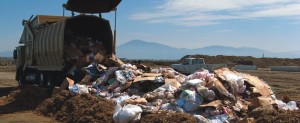
Incoming food waste is unloaded onto a prepared bed of green waste and wood chips to absorb free liquids and capture moisture for the composting process.
Laying The Groundwork
While nonfood materials such as soiled paper products and wet or waxy cardboard boxes are commonly added to food composting programs, field observations indicate this approach falls short of really capturing leftover food discarded in noncompostable packaging. This part of the problem tends to increase as food packaging industries trend away from heavier paper and cardboard toward lighter plastic. An example is individual food servings, which do not lend themselves to separation of food waste. As a result, significant tonnages of packaged food waste will be missed by conventional “food and soiled paper” diversion programs. Thus, while there may be plenty of food waste in the waste stream, there may not be enough in a “targetable” state to reach goals without handling the noncompostable packaging. These are the materials targeted by the FWCS.Initially, just packaged food waste from a large-scale ice cream manufacturer was accepted in order to experiment with packaging material in the composting process. After years of refining the composting process and studying the waste stream from local school districts, the City began taking in loads from schools. Once additional pilot testing was completed, the FWCS was ready to expand. In 2011 the system was phased in at all 53 schools in the City of Bakersfield over a 6-month period. As part of this expansion, approval was also given for more organics material from the ice cream manufacturer used during the pilot testing period.
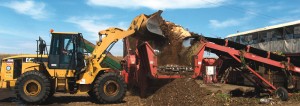
A roughly 50:50 mix of food waste and green waste is fed into a Morbark horizontal grinder and reduced to a 4-inch particle size. Feedstock trapped in packaging or external bagging is released.
The organics bin is serviced daily (Monday through Friday) by a specially assigned city refuse truck. The truck is powered by liquid natural gas to reduce diesel exhaust, consistent with air pollution control district goals. The truck is fitted with a special tailgate seal to contain the many liquids collected in school food waste. The school route collects about 9 tons/day for composting. The ice cream manufacturer produces from 15 to 40 tons/day of compost feedstock, consisting mostly of test batches and expired goods, along with some products in damaged packaging.
The system has been so well received by area organics material generators that plans are already being put into place to expand the system, including schools in the surrounding Kern County unincorporated areas. The nearby City of Arvin also has begun using the system to manage its combined food waste and green waste from its residential recycling program. The FWCS is integrated with the rest of the City’s green waste composting program and municipal waste management system, as well as the unincorporated Kern County system. Both jurisdictions support the system with solid waste enterprise funding. User fees for food waste collection routes are structured to create an economic incentive for schools and institutions to compost and reduce disposal.
An economic analysis was done on use of compostable versus regular plastic liners based on 32-gallon barrels. Compostable liners cost about $0.70 each compared to $0.10 each for regular plastic. Field data indicates that school cafeteria waste uses about 100 bags/ton. Thus, the cost differential for compostable bags would be about $60/ton over the normal plastic bags. Therefore, the program is designed to accept and handle regular plastic bags from food waste generators. Using the same method of evaluating initial cost versus long-term savings, dumpster diving exercises were done to determine how many polystyrene foam trays were in a typical school refuse bin and what the actual cost per tray was for disposal. That cost was added to the purchase cost of the polystyrene tray. This information was provided to school district managers, who then saw the benefit of switching to trays made from paper.
Cafeteria food service varies between schools, with some using a central kitchen where meals are mass-produced, wrapped and delivered in lunch boxes. Others use cafeteria trays with dishes. Students are encouraged to separate food from its packaging, putting the contents in the compost barrel and the packaging in the trash. If they don’t do the separation, the entire package is put in the compost barrel. Visual inspection of the contents of food waste bins is done by the route driver, who uses “red tagging” for reject materials.
Materials Receiving And Processing

The Food and Wrapper windrows are built between soil berms (right) to confine the plastic shreds from blowing into the green waste only windrows. A litter fence surrounds that composting area (far right).
Incoming food waste is unloaded onto a prepared bed of green waste and wood chips to absorb free liquids and capture moisture for the composting process. Visual inspection of the food waste packer loads are conducted before they are ground. A roughly 50:50 mix of food waste and green waste is fed into a Morbark 7600 horizontal grinder and reduced to a 4-inch particle size. Feedstock trapped in packaging or in external bagging is released and mixed with sufficient green waste. This method avoids the need for additional debagging equipment and labor.
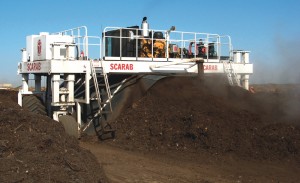
The 20-foot wide Scarab is equipped with paddles instead of flails, preventing plastic packaging and bag material from being broken into smaller pieces in the windrow.
The compost turner is also equipped with a plow to make furrows on top of windrows as it passes over them. This attachment was developed in-house as a means to conserve water, letting it soak in the top furrows instead of running down the face of the windrow.
The city also modified the spray nozzles on its water truck in two ways to save water. The nozzles are mounted on risers and the spray patterns are adjusted to apply water only on top of the windrows in the furrows mentioned above. This reduces water consumption by about 30 percent.

The trommel (left has a combination of larger primary and smaller secondary screen openings. Oversized pieces are removed in the primary screen and pass under a vacuum (right), sending a more uniform range of material sizes to the second screen.
Bulk handling of finished compost is partially automated by electric powered transfer conveyors that carry the product from the screens to the storage area without double handling, eliminating the need for a diesel loader. Two-thirds of the finished compost is sold to the agricultural market. Revenues have actually increased for the compost, instead of decreasing them as many plastic handling composters have experienced. From Fiscal Year (FY) 2009-2010 to FY 2011-2012, revenues more than tripled to almost $150,000.
Cost And Diversion Data
The cost of composting food waste and packaging on a large scale has remained about the same as regular green waste processing, ranging from $28 to $32/ton. The operation is efficient as it uses existing equipment and facility infrastructure with minimal extra steps. Collection is accomplished by simple rerouting of existing collection operations, using equipment freed up by reduced disposal. Composting is accomplished by blending in food waste and wrapper feedstock to an existing green waste composting operation. These operational efficiencies are quite good; however, the program’s fundamental purpose of composting wrapper material makes it achieve a much greater percentage of food waste diversion compared to conventional programs.
Based on the tonnage already collected for 2012, there has been over a four-fold increase from the tonnage recycled during the same period in 2011. Continuing with this trend, there will be a projected increase of 11,931 tons of recycled organic materials from 2011 to 2012. By the end of 2012, with the organics collected during the pilot period, nearly 25,000 tons of material will have been diverted from the landfills and reused as compost. The schools are experiencing cost savings with regard to collection. The cost for trash service only for a 12 month period (prior to implementation of FWCS) is estimated at $14,145. The 3-stream approach — compost (FWCS), recycle and trash — is estimated at $6,194 for a 12-month period.
Education
The Food and Wrapper Composting program has been extremely successful in raising awareness in the community — especially among students. A significant amount of time is given by City of Bakersfield staff for education. For example, two outgoing and kid-friendly refuse truck drivers were chosen for special duty to present the composting program to the students, with great success. Simple, but illustrative visuals are used to reinforce the message.
After the food waste has been turned into compost, the same refuse truck drivers bring back samples of the material for students to examine and use in school gardens. Education and awareness is also achieved by guided tours of the green waste facility that show the steps needed for food waste to become compost. Although Bakersfield does not currently recycle postconsumer residential food waste, it will be much easier to plan and execute such a program in the future as these children grow up with the awareness created by this system.
Kevin Barnes is the Solid Waste Director for the City of Bakersfield, California. He grew up in the refuse business, and enjoys using his 35 years of experience to face new challenges.


